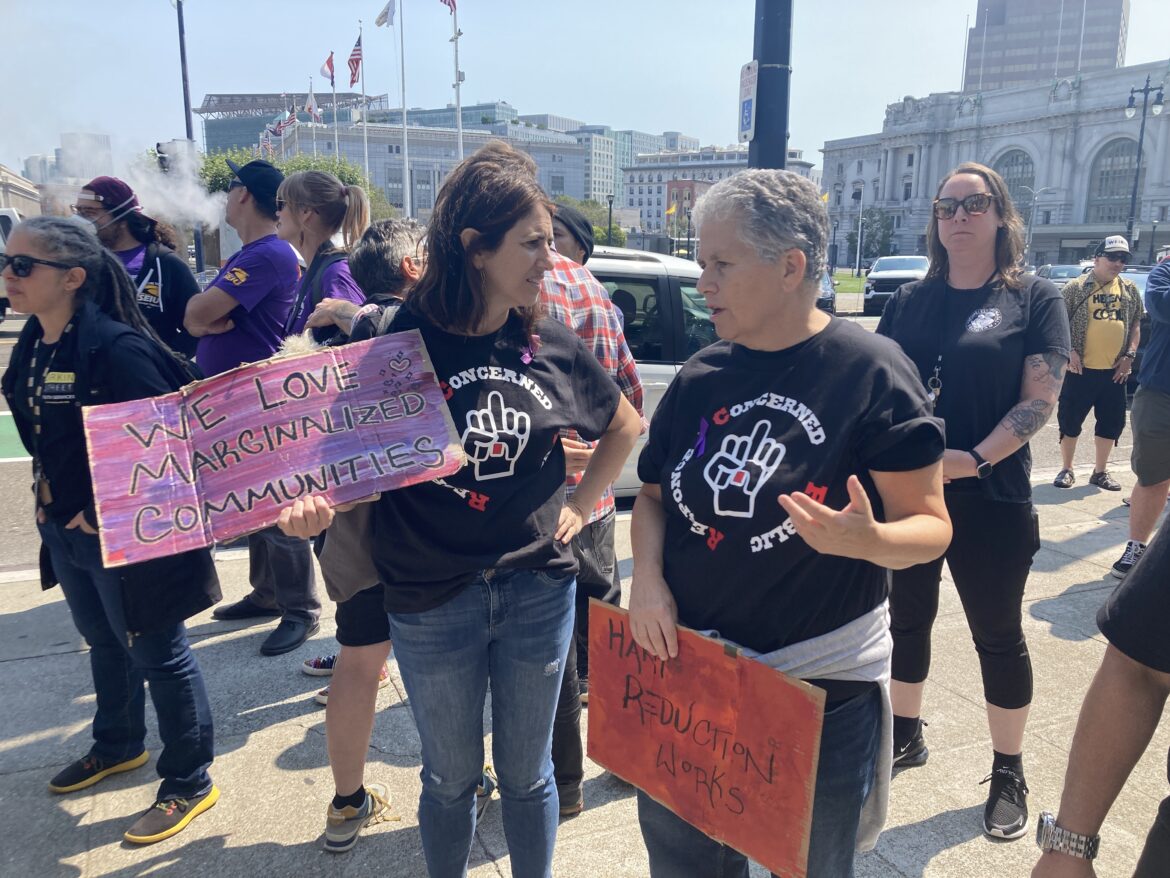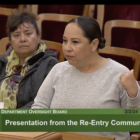This article is adapted from an episode of our podcast “Civic.” Click the audio player below to hear the full story.
Several weeks after a crucial legal hurdle blocking safe consumption sites in San Francisco was seemingly resolved, proponents said they were dismayed that city leaders and public health officials were still not greenlighting centers that could reduce deaths related to drug use.
Overdose deaths have reached 620 this year — on track to have the highest annual tally since counting began, with fentanyl causing the vast majority of fatalities, according to the chief medical examiner’s latest report.
The Department of Public Health advocated for safe consumption sites — also known as overdose prevention centers or OPCs — in its 2022 Overdose Prevention Plan. These are places where people can consume drugs under supervision and get immediate help if they overdose, and where they can receive basic healthcare, hygiene services, food, and referrals to detox and treatment upon request.
But the department now appears to be hedging, said Supervisor Hillary Ronen.
“DPH gave us an initial timeline that had the first OPC opening in March of 2025,” she said. “Clearly, that’s not an urgent priority to deal with the fact that two to three people a day are dying of drug overdose.”
In Episode 5 of the podcast series, “The Fight for Safe Consumption Sites: San Francisco and the Overdose Crisis,” we investigate San Francisco’s long campaign for places where people could take drugs under supervision in case they overdose and how city leaders may be having a change of heart about supporting the sites, and we visit one such overdose prevention center in New York City. Read our previous coverage on this storyline.
Overdose prevention centers have operated in Canada and Europe for more than 20 years — and none of those centers has ever recorded a death, according to studies published in academic journals. Studies have shown that in communities where centers were located, their presence correlated with improved client health, reduced public nuisance, an increase in detox services, higher rates of long-term addiction treatment and, over time, reduced use of the sites for injecting drugs. And a cost-benefit analysis published in December 2016 in the Journal of Drug Issues showed that a single safe consumption site could save San Francisco’s public health system $3.5 million annually.
Mayor London Breed supported the 2022 plan and in the last two-year budget included $18.6 million for wellness hubs that would offer overdose prevention services. But City Attorney David Chiu warned that opening such sites could violate so-called “crackhouse” laws, federal statutes that, among other things, make it illegal to “knowingly open, lease, rent, use, or maintain any place, whether permanently or temporarily, for the purpose of manufacturing, distributing, or using any controlled substance.” Last April, Breed and Chiu agreed that to avoid breaking the law, the city could fund a wellness hub with wraparound services like healthcare if the safe consumption portion of the center was privately funded.
One local organization appears to have solved that part of the puzzle. On Oct. 5, Gary McCoy, vice president of policy and public affairs for HealthRight 360, a nonprofit contracted by San Francisco to provide treatment services, announced that his organization had raised the funds needed to operate an overdose prevention center.
The San Francisco Examiner on that day quoted a health department statement asserting that it was unaware that a nonprofit had succeeded in raising funds. Five days later, in an email to the Public Press, the department provided the same statement: “We have not been informed that any nonprofit has succeeded in raising funds. However, once the funds are raised, there are a number of complex legal, procurement, location, and community factors that need to be addressed.”
[Double your year-end gift to the Public Press during NewsMatch, a national campaign that supports nonprofit newsrooms by matching donations dollar for dollar.]
McCoy said he has noticed a lack of urgency regarding overdose prevention centers, adding that the city is now “barely discussing” implementing wellness hubs. He said he also noticed the increasing politicization of harm reduction strategies, a collection of practices that address health needs without requiring that those receiving help abstain from drugs or alcohol, or that they enter treatment for addiction.
“There’s been a very vocal, small group of people that have been really hammering this messaging — that they’re condemning San Francisco for progressive policies and talking about ‘this is why the city has failed,’” McCoy said.
Among those speaking against harm reduction is a new political lobbying group called TogetherSF Action, which is campaigning against overdose prevention centers, arguing that they are an ineffective way to connect people to treatment.
“These people are somehow getting the ear of our policymakers over the dedicated staff that have worked in these departments, that have the medical training, that have the lived experience,” McCoy said.
San Francisco pioneered the harm reduction philosophy in 1967 when the Haight Ashbury Free Medical Clinic provided healthcare to crowds of young people who heeded the call to “turn on, tune in and drop out.” It’s a healthcare approach that does not require people to stop taking drugs to get support. Instead, the goal is to help improve the health of people suffering from addiction by providing clean drug supplies, basic medical and hygiene care, some food and shelter.
But today, some local leaders, like Supervisor Matt Dorsey, are seeking to redefine those principles.
“We do have to take the principles of harm reduction seriously, in that part of it is reducing harms to the community,” Dorsey said.
Dorsey said the city’s permissiveness around drugs has resulted “in a level of drug tourism or San Francisco becoming a destination city for drug use.”He quoted a statistic from a report presented by Police Chief Bill Scott to the Police Commission last June indicating that 95% of people arrested for drug use that month were not from San Francisco.
Data from the chief medical examiner may challenge the drug tourism theory: A report released in October showed that 92% of people who died of overdose from January to September this year were from San Francisco.
Alex Kral, a San Francisco-based epidemiologist with expertise in substance use and overdose prevention centers, said the notion that harm reduction services encourage drug users to come to San Francisco “doesn’t really make any sense.”
“There’s no data showing this,” Kral said. “In general, the people who go to these types of services are people who’ve come to terms with the fact that they’ve been using drugs a long time, they’ve got a problem, and they need some help.”
Even though proponents fear that support for overdose prevention centers is waning among city leaders, they are not giving up. Activists have been running pop-up safe consumption sites in areas of the city where overdoses are most prevalent.
Ronen participated in one such site on Aug. 31 — International Overdose Awareness Day. But she said that was an act of civil disobedience, not a replacement for the real overdose prevention model.
“Why the model is so wonderful is you can actually save people’s lives and do this really positive health intervention, and at the same time, address one of the worst things happening in San Francisco right now, which is the really chaotic streets conditions in certain neighborhoods,” she said.
Ronen said that when her office approached Breed’s office for a renewed commitment to overdose prevention sites, they were stalled yet again.
“I think there’s a good chance that HealthRight 360 is going to have to give back hundreds of thousands of dollars, and that we’re just going to see more and more people die of drug overdose in the city,” Ronen said.
Meanwhile, Breed and law enforcement officials have vigorously campaigned on a strategy involving arresting people under the influence of drugs, despite health department advice to the contrary. In its 2022 Overdose Prevention Plan, the Department of Public Health noted that punitive policies “have not been shown to be effective at reducing overdose deaths, while incarceration is known to significantly increase risk of dying of drug overdose.”
Ronen said the health department’s silence regarding the mayor’s approach is irresponsible.
“The Department of Public Health just does what she tells them to do, which is also a problem. Because in my opinion, they’re doctors, they have a duty to do everything in their power to save their patients’ lives,” Ronen said.
The mayor’s office did not respond to a request for comment.
About the Series
As San Francisco continues to search for solutions for homelessness and overdose deaths, the Public Press’ “Civic” audio team is exploring the origins of these crises, what has been done to help and what might be making things worse.
Throughout our six-episode series, we are exploring what influenced rampant opioid addiction and its connection to homelessness, the 150-year history of policing and prosecuting drugs in San Francisco, the long battle to open a safe consumption site in the city and grassroots efforts to curb the tide of deaths.










